

Zitierweise / cite as:
Carakasaṃhitā: Ausgewählte Texte aus der Carakasaṃhitā / übersetzt und erläutert von Alois Payer <1944 - >. -- Anhang B: Tierbeschreibungen. -- Rhinocerotidae. -- Fassung vom 2010-12-09. -- URL: http://www.payer.de/ayurveda/tiere/rhinocerotidae.htm
Erstmals publiziert:
Überarbeitungen:
Anlass: Lehrveranstaltung SS 2007
©opyright: Dieser Text steht der Allgemeinheit zur Verfügung. Eine Verwertung in Publikationen, die über übliche Zitate hinausgeht, bedarf der ausdrücklichen Genehmigung des Verfassers
Dieser Text ist Teil der Abteilung Sanskrit von Tüpfli's Global Village Library
WARNUNG: dies ist der Versuch einer
Übersetzung und Interpretation eines altindischen Textes. Es ist keine
medizinische Anleitung. Vor dem Gebrauch aller hier genannten Heilmittel wird
darum ausdrücklich gewarnt. Nur ein erfahrener, gut ausgebildeter ayurvedischer
Arzt kann Verschreibungen und Behandlungen machen!
Falls Sie die diakritischen Zeichen nicht dargestellt bekommen, installieren Sie eine Schrift mit Diakritika wie z.B. Tahoma.
Verwendete und zitierte Werke siehe: http://www.payer.de/ayurveda/caraka000b.htm
In Indien kommen vor:
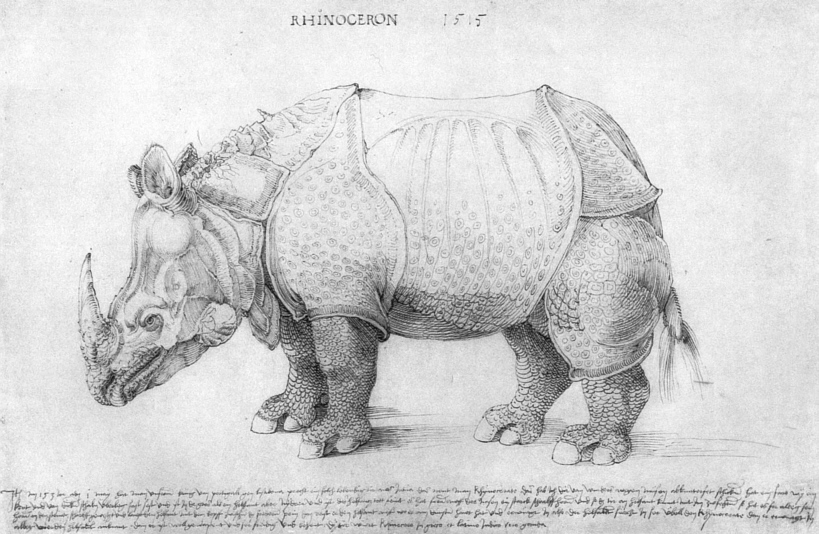
Abb.: Albrecht Dürer (1471–1528): Rhinoceron, 1515,
Vorlage für den gleichnamigen Holzschnitt 1515
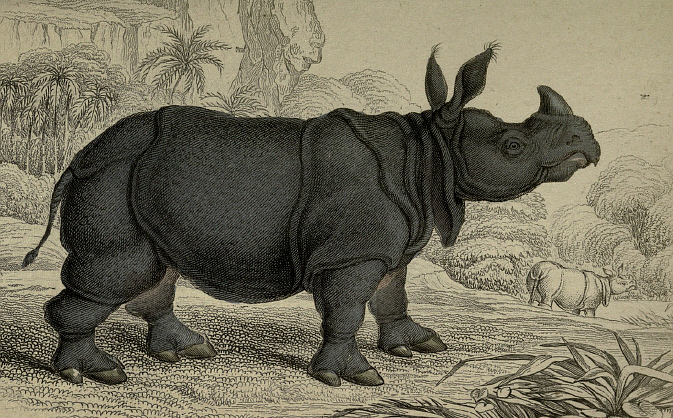
Abb.:
Rhinoceros unicornis - Panzernashorn
[Bildquelle: The naturalist's library. -- Vol. 23. -- 1834ff.]
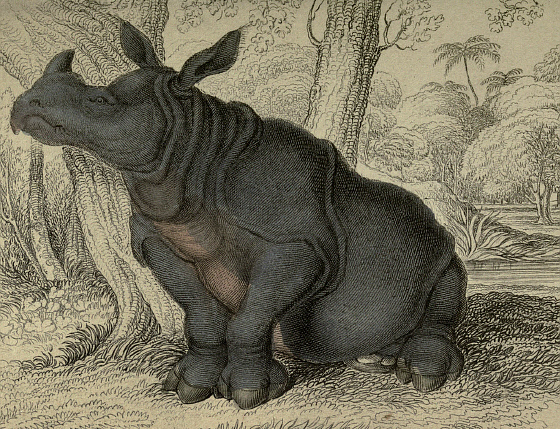
Abb.:
Rhinoceros unicornis - Panzernashorn, Liverpool Zool. Gardens
[Bildquelle: The naturalist's library. -- Vol. 23. -- 1834ff.]
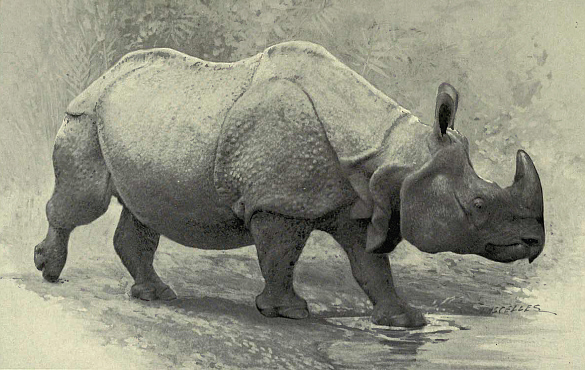
Abb.:
Rhinoceros unicornis - Panzernashorn
[Bildquelle: Ainsworth Davis: Natural history of animals. -- 1903ff.]
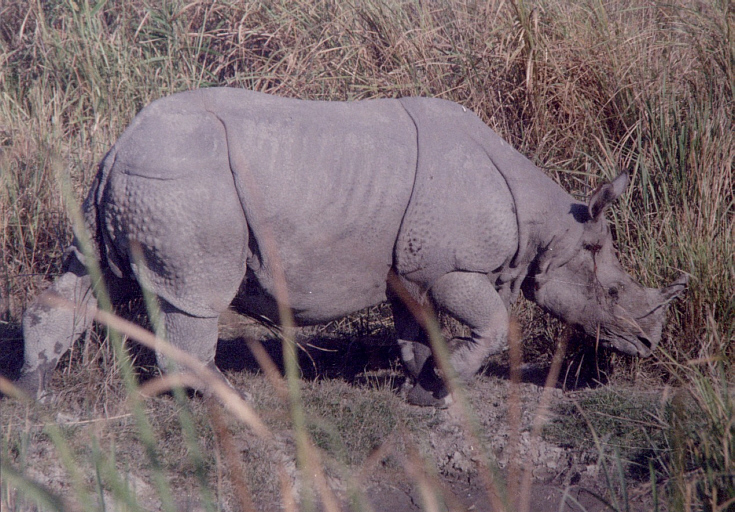
Abb.:
Rhinoceros unicornis - Panzernashorn, Kaziranga National Park
(কাজিৰঙা ৰাষ্ট্ৰীয় উদ্যান), Assam (অসম)
[Bildquelle: Deepraj / Wikipedia. -- GNU FDLicense]
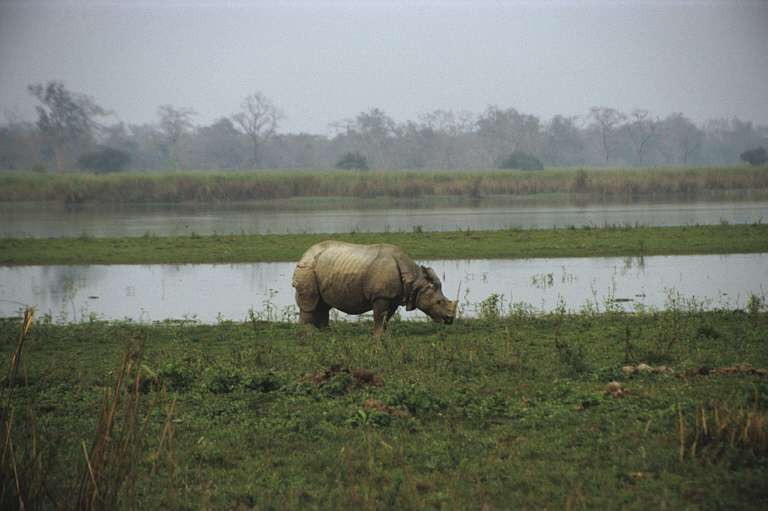
Abb.:
Rhinoceros unicornis - Panzernashorn, Kaziranga National Park
(কাজিৰঙা ৰাষ্ট্ৰীয় উদ্যান), Assam (অসম)
[Bildquelle:
gozef. -- http://www.flickr.com/photos/gnozef/343982248/. -- Zugriff am
2007-07-17. --
![]() Creative
Commons Lizenz (Namensnennung)]
Creative
Commons Lizenz (Namensnennung)]
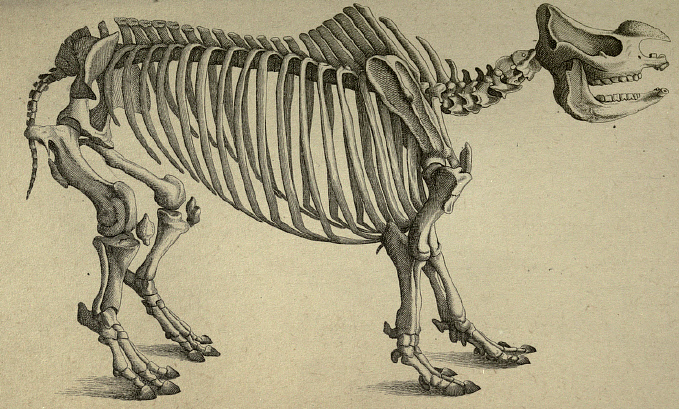
Abb.:
Rhinoceros unicornis - Panzernashorn, Skelett
[Bildquelle: The naturalist's library. -- Vol. 23. -- 1834ff.]
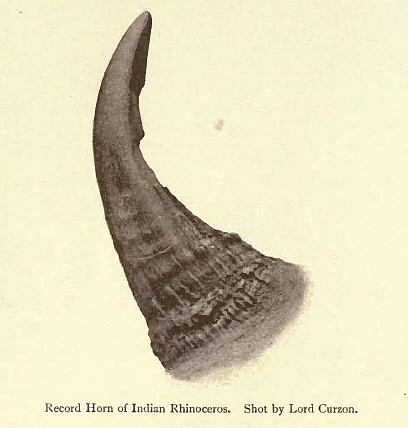
Abb.: Horn von
Rhinoceros unicornis
[Bildquelle: Ward, 1903]
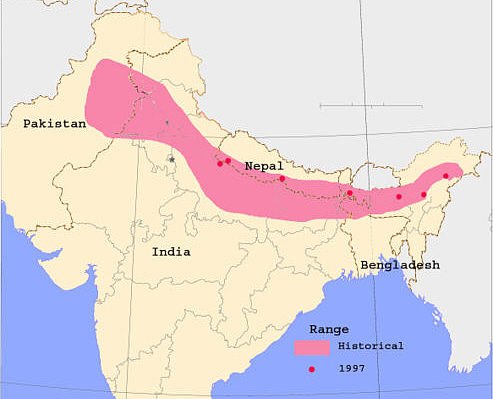
Abb.: Verbreitungsgebiet von
Rhinoceros unicornis - Panzernashorn
[Bildquelle: Christophe cagé / Wikipedia. -- GNU FDLicense]
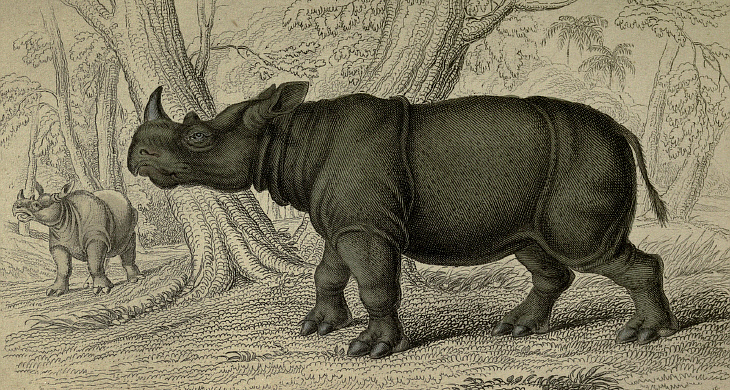
Abb.:
Dicerorhinus sumatrensis - Sumatranashorn
[Bildquelle: The naturalist's library. -- Vol. 23. -- 1834ff.]
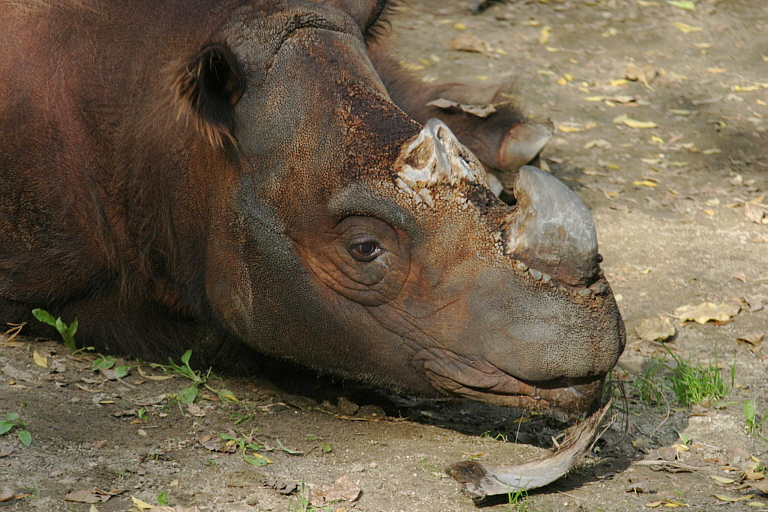
Abb.:
Dicerorhinus sumatrensis - Sumatranashorn
[Bildquelle:
Squiggle. -- http://www.flickr.com/photos/stephenr/383314979/. -- Zugriff am
2007-07-17. --
![]()
![]()
![]() Creative
Commons Lizenz (Namensnennung, keine kommerzielle Nutzung)]
Creative
Commons Lizenz (Namensnennung, keine kommerzielle Nutzung)]
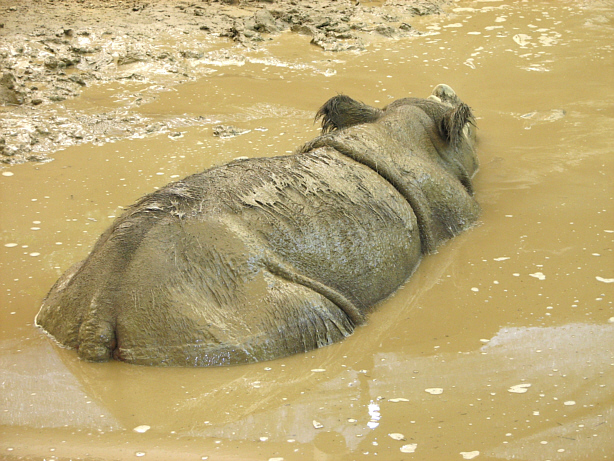
Abb.: Sumpfliebhaber:
Dicerorhinus sumatrensis - Sumatranashorn
[Bildquelle: Ltshears / Wikipedia.
-- Public domain]
Lydekker:
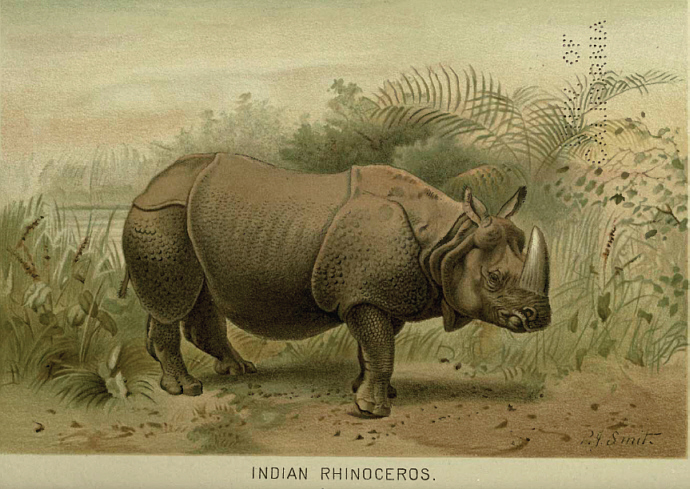
"THE ASIATIC RHINOCEROSES.
The whole of the three species of rhinoceroses inhabiting Asia are characterised by
the skin being thrown in places into thick folds, and by the presence of teeth in the front of the jaws ; the horns being either one or two in number. By far the largest of these three is the great one-horned Indian rhinoceros (R. unicornis), which may be conveniently designated as the Indian rhinoceros par excellence, and is the one which has been longest known in Europe from living examples, a specimen having been sent to Portugal as long ago as the year 1513. In this species there is but a single nasal horn ; and the skin, with the exception of that of the tail and ears, is naked, and on the sides of the body studded with a number of large convex tubercles, reminding one of the rivets in an iron boiler, which are largest on the fore and hind-quarters, where they may be as much as an inch in diameter. The skin of the body is divided into a number of shield-like pieces by the aforesaid folds. Thus there is a fold before and behind each shoulder, marking off a large triangular shield covering the shoulder; and another in front of each thigh dividing the large saddle-shaped body-shield from the one on the hind-quarters. The folds behind the shoulder and in front of the hind-quarters continue completely across the back, but the one in front of the shoulder inclines backwards and dies out close to the second great fold. Other folds form great rolls of skin on the neck, while there are others below the shields on the fore and hind-quarters and one situated behind the buttocks which forms a groove for the reception of the tail. The head is very large in proportion to the body, with the occipital region of the skull very much elevated ; and the ears are large, with their tips fringed with hairs. The horns are large in both sexes ; and the colour of the skin is a uniform blackish grey. In height the Indian rhinoceros stands from 5 feet to 5f feet at the shoulder. In a male standing 5 feet 9 inches at the shoulder, measured by General Kinloch, the length from the tip of the snout to the root of the tail was 10 feet 6 inches, the length of the tail 2 feet 5 inches, and the girth of the body 9 feet 8 inches. The length of the horn is seldom more than a foot, although Jerdon says that there are instances on record of horns of 2 feet in length, and one in the British Museum measures 19 inches.The Indian rhinoceros is further characterised
by its teeth. As a rule, there is but a single pair of broad incisors in the upper jaw, although in some cases there may be a smaller pair behind them. In the lower jaw there is one pair of long, triangular, pointed tusks, and between them a pair of small cylindrical incisors which can be of no functional importance. The upper molar teeth have tall crowns, and in the absence of a buttress at their front outer angle, and the flat plane formed by their worn surface, resemble the one represented in the lower figure on p. 464. They are, however, distinguished from the latter by the presence of a small vertical plate, projecting from the outer wall into the extremity of the middle valley. It will be obvious that this flat plane of wear of the cheek-teeth implies that the jaws have a backwards-and-forwards grinding motion, and not a champing action ; such a mode of mastication being similar to that existing in horses and cattle.
This rhinoceros is exclusively confined to India, and at the present day, according to Mr. Blanford, is almost restricted to the Assam plain, being rarely, if ever, found to the westward of the Tista River. Twenty
or thirty years ago, it was, however, still common in the so-called terai country at the foot of the Sikhim Himalaya, while some years earlier it frequented the sub-Himalayan districts of Nipal, and ranged as far west as Rohilcund ; while the writer last quoted believes that, about the year 1850, it also occurred in the grass-jungles of the Ganges valley at the north end of the Rahmahal Hills in Bengal. In the early part of the sixteenth century it ranged over the Punjab as far westwards as Peshawur ; and since its fossilised remains are found in the North-West Provinces, the Narbada valley, and Madras, it may be inferred that the Indian rhinoceros formerly ranged over the greater part of Peninsular India, in localities suited to its habits.The Indian rhinoceros is a denizen of the great grass-jungles that cover such a large portion of the plains of India, and from this circumstance, coupled with the general resemblance of its molar teeth to those of the African Burchell's rhinoceros, which is
known to be a grass-eater, it may be assumed that its food is chiefly grass. Regarding the density and height of these jungles, General Kinloch writes that, "year after year, in the short space of two or three months, these giant grasses shoot up to a height of from twenty to thirty feet, forming, with the wild cardamum, various other broad-leaved plants, and numerous creepers, a tangled cover which shelters the elephant, the rhinoceros, and the buffalo, as effectually as a field of standing corn affords concealment to the partridge or the quail. I have seen a line of about fifteen elephants beating a strip of reeds not more than two hundred yards in width, and I could hardly see the grass shake. There was not as much commotion or indication of what was going on, as would be caused by a pack of beagles drawing a gorse-cover. Runs or tunnels among the high reeds, like magnified 'meuses' of hares and rabbits, show that the same paths through the thick jungle are generally made use of."The rhinoceros chiefly frequents such portions of these grass-jungles as are on swampy ground ; and although it is in general a solitary animal, the writer just quoted states that he has
known half a dozen individuals roused from a belt of not more than half a mile in length by three hundred or four hundred yards in width.Like tapirs, the Indian rhinoceros is fond of a mud-bath. Although there are many stories extant as to its ferocity, and more especially its enmity to the elephant, it appears that this animal is generally quiet and harmless. Even when wounded, according to Mr. Blanford, it is but seldom that it charges
home ; but when it does attack, the sharp lower tusks are used much after the same manner as those of a wild boar. The only sound that this rhinoceros utters is a peculiar grunt, which is repeated at frequent intervals during excitement. The usual gait of this rhinoceros is a long swinging trot, but when disturbed, it can break into an awkward but very rapid gallop. Only a single calf is produced at a birth, but there is some uncertainty as to the length of the period of gestation, an old writer stating that it is nine months, while a more recent authority affirms that it is nearly or quite double as long. Since rhinoceroses, so far as we are aware, have not bred in captivity in Europe, the point is one not likely to be soon cleared up. The Indian rhinoceros thrives well in confinement, and frequently lives in that state for a long period. One specimen acquired by the London Zoological Gardens in 1834 lived till 1849, while a second, purchased in 1850, died in 1874, and a third presented in 1864 is still (1894) flourishing. Mr. Blanford states that he has heard of captive specimens living fifty or sixty years, and Mr. Brian Hodgson was of opinion that the natural term of this animal's life is upwards of a century.From the immense thickness and apparent toughness of its enormous folds, it was long considered that the hide of the Indian rhinoceros
was bullet-proof, and that the only places where the animal was vulnerable were the joints of the armour. General Kinloch relates an amusing story of a soldier in India, who had heard of this legend, firing point-blank at a tame rhinoceros which had been captured by his regiment during the Mutiny, in order to obtain ocular proof of its truth. Needless to say, as the shot was well aimed, the unfortunate animal fell dead, which meant a considerable loss to the regimental prize-fund. And we may mention here that the Indian rhinoceros, like all its kindred, when shot sinks down in its tracks, and lies as if asleep, instead of falling over on its side like most other mammals.As a matter of fact, the skin of the living animal is quite soft, and can readily be penetrated in any place
by a bullet, or easily pierced by a hunting-knife. When dried it becomes, however, exceedingly hard ; and it was formerly employed by the Indian princes in the manufacture of shields for their soldiery. General Kinloch states that if polished the hide "is very handsome and semi-transparent, and when held up to the light looks exactly like tortoise-shell, the tubercles giving it a beautiful mottled appearance."The horn is used
by the Hindus (to whom in common with the natives of most parts of India, the animal is known by the name of gainda) in some of their religious ceremonies ; when manufactured into cups it is considered by the Chinese to possess the property of indicating the presence of poison.There are two modes, according to General Kinloch, of hunting the Indian rhinoceros "one by quietly tracking up the animal on a single elephant until he is at last found in his lair, or perhaps standing quite unconscious of danger; the other, by beating him out of jungle with a line of elephants, the guns being stationed at the points where he is most likely to break cover. In the latter case it is necessary to have reliable
men with the beaters, who can exercise authority and keep them in order, for both mahouts and elephants have the greatest dread of the huge brute, who appears to be much more formidable than he really is."The same writer gives his experience of rhinoceros-hunting as follows.
On a certain occasion the General and his party " had tracked a wounded buffalo into a large and very thick cover, into which it was useless to follow him with any chance of getting a shot. The three guns, therefore, went on ahead, and took up their positions at the other end of the cover, while the pad-elephants were ordered to form line and beat steadily through the jungle. After waiting a long time at my post I heard some large animal crashing through the reeds, and as the line of beaters advanced the waving of the grass betrayed its movements. It came on very slowly, occasionally stopping for some time to listen, and again making a cautious advance. I remained still as death, but I was in a great state of anxiety lest my elephant should become uneasy and give the alarm. Fortunately, he remained silent, and at length the rhinoceros, anticipating no danger ahead, and pressed by the steadily advancing line of elephants behind him, poked his ugly head out of the reeds within twenty yards of me. I could only see his snout and his horn, and aimed above the latter for his forehead. I either took a bad aim, or my elephant moved slightly as I fired, for, as I afterwards found, my bullet merely grazed the snout, cutting a deep furrow along the base of the horn. As the rhinoceros wheeled round, I gave him another bullet in the centre of his ribs, and he rushed back into the reeds and through the beaters with an angry grunt." On search being made in the jungle, it was found that the second bullet had done its work, the huge animal lying dead with its legs folded beneath the body in the usual recumbent posture.The Javan, or lesser one-horned rhinoceros (R. sondaicus), is an altogether smaller animal than the preceding, with the head relatively less large in proportion to the body, although its height at the shoulder is scarcely, if at all, inferior. The skin, which is nearly or quite naked, lacks the large tubercles of the Indian rhinoceros ; while the fold in front of the shoulder, instead of inclining backwards, is continued right across the body like the other two main folds. Superficially, the skin is divided
by a network of cracks into a number of small mosaic-like discs. The great folds of skin which are so conspicuous in the neck of the Indian rhinoceros are in this species much less strongly developed. The general colour is a uniform dusky grey. The skull is less elevated than in the larger species in the occipital region ; but there are the same number of front teeth. In structure the upper molar teeth are, however, simpler, resembling the lower of the two figured on p. 464 ; and their crowns are not so tall. Measurements of wild individuals appear to be very few ; but in a large female the height at the shoulder was 5½ feet. The female is generally or invariably hornless.This species has a
much more extensive distribution than its larger cousin. There is no evidence that it ever occurred in Peninsular India, but it is found in the Bengal sundarbans and portions of Eastern Bengal, while it has been met with in the Sikhim "terai." From the valley of Assam it ranges eastwards through Burma and the Malay Peninsula to Sumatra, Java, and Borneo ; its partially fossilised remains occurring in the latter island.Mr. Blanford observes that this species "is more an inhabitant of the forest than of grass, and although it is found in the alluvial swamps of the sundarbans, its usual habitat appears to be in hilly countries. It has been observed at considerable elevations both in
Burma and Java." Indeed, there is evidence that it probably ascends occasionally to as much as seven thousand feet above the sea-level. This species being a forest-dwelling one, while its molar teeth are of the same pattern as those of the leaf and branch-eating common African rhinoceros, it is pretty certain that its food must be of the same general nature as that of the latter. In disposition the Javan rhinoceros is said to be more gentle than the large Indian species, and it is not unfrequently tamed by the Malays. The horns are never large, and afford but poor trophies to the sportsman.In the Pliocene rocks of the Siwalik Hills at the foot of the Himalaya there occur remains of a single- orned rhinoceros (R. sivalensis), which appears to have been closely allied to the Javan species, of which the original
home may accordingly have been India. More remarkable, however, is the occurrence of a fossil rhinoceros in the interior of the Himalaya, at an elevation of about sixteen thousand feet above the sea-level, which likewise seems to have been related to the same species. It may be added that another fossil Indian rhinoceros (R. palaeindicus), of which an upper molar teeth is represented in the lower figure on p. 464, appears to have been the forerunner of the living great Indian rhinoceros; its molar teeth approximating to those of the latter, although of a rather less complex structure.
Reverting to the living Asiatic species, the last of all is the Sumatran rhinoceros (R. sumatrensis), which is mainly characteristic of the countries to the eastward of the Bay of Bengal, occurring but rarely in Assam, although a single example has been obtained from Bhutan. From Assam it ranges through Burma and the Malay Peninsula to Siam, Sumatra, and Borneo ; but it is quite unknown in Java.
This is the smallest of all the living species of rhinoceros, and differs from the preceding kinds in carrying two horns. It is further distinguished by its hairiness, although there is a certain amount of individual variation in this respect. As a rule, the greater part of the body is thinly covered with brown or black hair of considerable length, while there are larger or smaller fringes of hair on the ears and tail. The skin, which is rough and granular, and varies in colour from earthy brown almost to black, has the folds much less developed than in the single-horned species, and only the one behind the shoulders is continuing right across the back. The two horns are placed some distance apart, and when fully developed are thick and massive at the base, but very slender above, the front and longer one sweeping backwards in a graceful curve. In many specimens the horns are, however, very short, and in examples kept in confinement like the one from which our figure is taken, they become worn down to mere stumps. The Sumatran rhinoceros differs from its two Asiatic cousins in having lost the pair of small incisor teeth in the lower jaw, in the front of which only the tusks remain, and even these are sometimes shed in old age. In these respects, therefore, this species, concomitantly with the presence of two horns, shows an indication of approximating to the African rhinoceroses.
In addition to the variation in the degrees of development of the hair, this species shows considerable individual differences in colour, and also in the relative breadth of the skull. A specimen purchased in 1872 by the Zoological Society of London for over £1000, and exhibited in their gardens, differed from the ordinary form by its superior size, paler and browner colour, smoother skin, shorter and more thickly-tufted tail, and the longer, finer, and more reddish-coloured hair; the latter forming a long fringe on the ears, of which the insides were naked. This animal had also a much wider head than ordinary. It was accordingly regarded as a distinct species, under the name of the hairy-eared rhinoceros (U. lasiotis) ; but there is little doubt that it cannot be considered as anything more than a well-marked variety of the Sumatran species.
There is considerable variation in regard to the dimensions of this species, but Mr. Blanford considers that from 4 feet to 4½ feet will represent about the average height at the shoulder. In the above-mentioned specimen the height at the shoulder was 4 feet 4 inches, and the length from the tip of the snout to the root of the tail 8 feet ; the weight of the animal being about 2000 lbs. On the other hand, in an adult female from the Malay Peninsula, the shoulder-height was only 3 feet 8 inches. There is also great variation in regard to the length of the horns, the hinder one being in some cases reduced to an almost invisible knob.
Mr. E. Bartlett gives the following particulars of Bornean specimens. In one example the front horn was 4½ and the second 2 inches in length ; in a second, while the front horn measured 5 inches, the hind one was a mere knob ; and in a third, the front horn had a length of 19 inches with a girth of 16 inches, the second horn being fairly developed, although not more than about 3 inches in height. A single specimen of a front horn had a length of 11 inches, with a basal girth of 11½ inches; but the maximum recorded length is upwards of 32 inches along the curve.
The molar teeth of this species are almost indistinguishable from those of the Javan rhinoceros, and as its habits appear to be very much the same as those of the latter, the diet of the two is probably also similar.
The Sumatran rhinoceros inhabits hilly forest-districts, and it has been observed in Tenasserim at an elevation of four thousand feet above the sea. It is a good swimmer, and is reported to have been seen swimming in the sea in the Mergui Archipelago. Although shy and timid in the wild state, in captivity it soon becomes tame.
Mr. E. Bartlett states that in Borneo the dyaks are very partial to the flesh of this species as an article of diet. And he adds that the kyans a race very distinct from the dyaks procure the horns for barter, for which they receive a high price from the Chinese, who import them to China for medicine. The horns are ground into powder for some diseases, while others are cut into minute fragments to carry about the person. The same writer further states that this rhinoceros is becoming extremely rare in the province of Sarawak, on account of the value set upon its horns, but in Central and North Borneo in the very old jungle it is more plentiful.
In 1872 a Sumatran rhinoceros, recently imported into London, gave birth to a calf; and this event afforded Mr. A. D. Bartlett data for considering that the period of gestation was a little over seven months. This however, as Mr. Blanford points out, seems a very short period for such a large animal, and contrasts very markedly with the length of time assigned by Hodgson to the great Indian rhinoceros."
[Quelle: Lydekker, Richard <1849-1915>: The royal natural history / edited by Richard Lydekker ; with preface by P.L. Sclate. -- London ; New York : F. Warne, 1893-96. -- 6 Bde. : ill. (some col.) ; 26 cm. -- Bd. 2. -- S. 465 - 472. -- Online: http://www.archive.org/details/royalnaturalhist02lyderich. -- Zugriff am 2007-09-27]
Blanford:
"Genus RHINOCEROS, Linn. (1766).
In this family also all living species are by most naturalists referred to a single genus. There are three toes on each foot, each toe terminating in a small hoof-like nail. The size is large, the general form is heavy, and the legs are short and stout. The skin in all living forms is thinly clad with hair or is naked, and in all Indian species it is thick (so much so, that it was formerly supposed to be bullet-proof) and thrown into deep folds in places. One or two dermal horns are situated on the median line above the snout. These horns grow throughout the animal's life, and if lost are reproduced. The head is large, the eyes small, and the ears moderate. There are two inguinal mammae.
The skull is elongate, with a high occipital crest. The nasal bones are large and united, broad behind, and in contact or nearly in contact with the large lachrymals ; they are arched in front and project over a wide space that separates them from the premaxillaries. There are no postorbital processes, the orbits opening into the temporal fossae. Tympanics small, not forming bullae. Dentition : i. 2(4)/2(4), c. 0/0, pm.4-4-/4-4, m. 3-3/3-3. The incisors are somewhat variable : all are deciduous in African species ; in adults of the Asiatic forms there are generally one pair, broad and blunt, in the upper jaw, and one or two pairs in the lower, the outer pointed and formidable weapons ; according to some these are lower canines. The anterior premolar in both jaws is very often wanting. The other upper premolars and molars are subquadrate with a longitudinal crest along the outer side and peculiarly incurved ridges on the inner; lower molars and premolars narrower, each formed of two crescentic ridges. The patterns on the teeth after wear are shown by the accompanying figure. Vertebrae : C. 7, D. 19-20, L. 3, S. 4, C. at out 22. Ulna and fibula well developed and distinct.
Fig. 153. Crowns of (a) upper and (b) lower second right true molars of Rhinoceros unicornis, the inner side uppermost.The genus is only found living in Africa and South-eastern Asia. Formerly it was widely distributed. Three extinct species, besides R. unicornis, have been recorded from the Pleistocene, and five from the Pliocene and Miocene beds of India.
Synopsis of Indian and Burmese Species.
- A single horn on the nose.
Fold in front of shoulder not continued over back of neck ; skin of sides bearing tubercles R. unicomis, p. 472.
Fold in front of shoulder continued over back of neck ; skin of sides divided into small polygonal scales R. sondaicus, p. 474.
- Two horns on nose R. sumatrensis, p. 476.
Rhinoceros unicornis. The great one-horned Rhinoceros.
Rhinoceros unicornis, L. Syst. Nat. i, p. 104 (1766) ; Hodgson, P. Z. 1834, p. 98 ; Gray, P. Z. S. 1867, p. 1010 ; Sclater, P. Z. S. 1871, p. 8 ; id. Tr. Z. S. ix, p. 645, pi. xcv ; Flower, P. Z. S. 1876, p. 454 ; W. Sclater, Cat. p. 202.
Rhinoceros indicus, Cuv. Règne An. i, p. 239 (1817); Blyth, J. A. 8. B. xxxi, pp. 151, 199 ; id. Cat. p. 136 ; Jerdon, Mam. p. 232; Lydekker, J. A. S. B. xlix, pt. 2, p. 135; Cockbum, J. A. S. B. lii, p. 56.
Rhinoceros stenocephalus, Gray, P. Z. S. 1867, p. 1018.Gainda, Gargadan, H. ; Karkadan, P. ; Gonda, Beng.
Skin naked except on the tail and ears, and on the sides studded with convex tubercles, half an inch to an inch or rather more in diameter, the largest on the buttocks and thighs and on the shoulders. Skin of body divided into great shields by folds before and behind each shoulder, and before each thigh ; the folds behind the shoulders and before the thighs continuous across the back, those in front of the shoulders not joined across the back but turning backwards and lost above the shoulder. There are also great folds round the neck, others below the shoulders and thigh-shields and behind the buttocks, so that the tail lies in a groove. Epidermis on limbs forming small polygonal scales. The head is higher and altogether larger than in other Asiatic species. Incisors generally 2/4 ; inner lower incisors small, outer large, pointed. Skull very high, mesopterygoid fossa narrow ; hinder margin of bony palate simply concave. Horn well developed in both sexes.
Colour blackish grey throughout.
Dimensions. Height at shoulder 5 feet to 5 feet 9 inches. A large male measured : height 5 ft. 9 in., length from nose to root of tad 10 ft. 6 in., tail 2 ft. 5 in., girth 9 ft. 8 in. (Kinloch). Length of horn rarely exceeding a foot. Basal length of a skull 23 inches, zygomatic breadth 15.3.
Distribution. At the present day the great Indian rhinoceros is almost restricted to the Assam plain, and it is very rare, if it exists, west of the Teesta river. Twenty to thirty years ago it was still common in the Sikhim Terai, and not many years previously it was found along the base of the Himalayas in Nepal and as far west as Rohilcund. Up to about 1850, or rather later, some rhinoceroses inhabited the grass-jungles on the Ganges at the north end of the Rajmehal hills, and were, I think, probably R. unicornis. Formerly this animal was extensively distributed in the Indian Peninsula. It was common in the Punjab as far west as Peshawar in the time of the Emperor Baber (1505-1530). Semifossilized remains of it have been found in the Banda district, North-west Provinces, and near Madras; and its co-existence with several mammals now extinct, the Indian hippopotamus for one, is shown by its occurrence in the Pleistocene beds of the Nerbudda Valley.
Habits. The great Indian rhinoceros is a denizen of the grassjungles, tracts of grass from 8 to 20 feet high, that cover so much of the uncultivated portions of the North-Indian alluvial plains. It appears never to ascend the hills ; it has a distinct preference for swampy ground, and is fond of rolling in mud. Though each animal is solitary as a rule, several are often found in the same patch of jungle.
Despite its bulk and strength, this rhinoceros is as a rule a quiet inoffensive animal, the stories of its ferocity and of its deadly enmity to the elephant, that were copied from the not very veracious pages of Captain Williamson's 'Oriental Field Sports' into European works on natural history, being fables. A rhinoceros when wounded or driven about will, however, sometimes charge home, though this is an exception. When it does attack, this species uses its sharp lower incisors (or, as some think, lower canines) much as a hog does. I was shown in Cooch Bebar a straight horizontal scar on the leg of one of the Maharaja's elephants just above the foot. This I was assured on good authority was the mark of a wound inflicted by a rhinoceros, and it is manifest such a wound could not have been produced by the horn (see also Blyth, J. A. S. B. xi, p. 891).
Fig. 154. Rhinoceros unicornis.The only sound known to be produced by the present animal is a peculiar grunt that it repeats frequently when excited. It is said by several writers to have a habit of depositing its dung in the same spot until a pile accumulates. The African R. bicornis has, I believe, no such habit.
Like other Ungulata, rhinoceroses can trot and gallop as well as walk. They as a rule sleep during the day and feed in the morning and evening. Their food consists, I believe, chiefly of grass. Their flesh is excellent, as I can testify. This rhinoceros is a longlived animal and, according to Hodgson, is believed to live 100 years. I have heard of individuals that had existed 50 or 60 years in confinement. The period of gestation is said by Hodgson to be 17 or 18 months, by Desmarest under 9 months, a single young one being produced.
Rhinoceros sondaicus. The smaller one-horned Rhinoceros.
Rhinocerus sondaicus
Rhinoceros javanicus, Cuv. Hist. Nat. Mam. livr. 45. pi. 309 (1824) ; Rainey, P. A. S. B. 1878, p. 139.
Rhinoceros inermis, Lesson, Complements du Buffon, ed. 2 i. p 514 (1848) ; Peters, MB. Akad. Berl. 1877, p. 68, pis. i-iii.
Rhinoceros nasalis and R. floweri, Gray, P. Z. S. 1867, pp. 1012, 1015.Gainda, H. ; Gondu, Beng. ; Kunda, Kedi, Kweda, Naga ; Kyeng, Kyantsheng, Burmese ; Bādāk, Malay.
Fig. 155. Rhinoceros sondaicus.Animal altogether smaller, though scarcely, if at all, lower at the shoulder than R. unicornis; head much smaller. Skin naked or nearly so, not tubercular, the epidermis divided by cracks into small, polygonal, subequal scale-like disks throughout the body and limbs. Surface of body divided into shields by folds, as in R. unicornis, but the fold in front of the shoulders is continuous across the back like that behind the shoulders and that in front of the thighs. Neck-folds comparatively little developed. Incisors generally 2/4 ; upper molars smaller and with a simpler pattern than those of R. unicornis ; skull and mandible of less height, mesopterygoid fossa broad. Hinder margin of bony palate produced in the. middle ; a partially ossified septum narium. The horn is frequently, perhaps always, wanting in the female.
Colour dusky grey throughout.
Dimensions. Rather less than those of R. unicornis, but most of the measurements published appear to be those either of young animals or of individuals in confinement, which very often do not attain their full growth. A large female, according to Mr. Fraser and Mr. Cockburn, was 5 feet 6 inches high. A skull measures 23 inches in basal length, 13.8 in zygomatic breadth.
Distribution. The Sundarbans and parts of Eastern Bengal; Kinloch shot an undoubted specimen in the Sikhim Terai. From Assam this rhinoceros is found throughout Burma and the Malay Peninsula, and in Sumatra, Java, and Borneo. Blyth states that this species was formerly found near Rajmehal, but does not give any reason for the identification. The statement, mentioned by Jerdon, that a few individuals existed in the forests of Orissa, has been ascertained by Mr. Ball and myself to be a mistake. So far as I am aware, there is no evidence at present that this rhinoceros ever inhabited the Peninsula of India. Its remains have, however, been found fossil in Borneo (P. Z. S. 1869, p. 409).
Habits. R. sondaicus is more an inhabitant of tree-forest than of grass, and although it is found in the alluvial swamps of the Sundarbans, its usual habitat appears to be in hilly countries. It has been observed at considerable elevations both in Burma and in Java; and the tracks seen by Major Macgregor south-east of Sadiya, at 7000 feet above the sea (Proc. E. Geog. Soc. 1887, p. 27), were probably made by this species. It is said to be more gentle and inoffensive than R. unicornis.
Rhinoceros sumatrensis. The Asiatic two-horned Rhinoceros.
Rhinoceros sumatrensis, Cuv. Règne An. i, p. 240 (1817) ; Sclater, P Z. S. 1872, p. 790, pi. lxvii ; id. Tr. Z. S. ix, p. 650, pi. xcvii ; Anderson, P. Z. S. 1872, p. 129; Bartlett, P. Z. S. 1873, p. 104, pl. xi ; Beddard 8f Treves, P. Z. S. 1889, p. 7 ; W. Sclater, Cat. p. 204.
Rhinoceros sumatranus, Raffles, Tr. L. S. xiii, p. 268 (1820) ; Blyth, J. A. S. B. xxxi, p. 151 ; id. Cat. p. 137.
Rhinoceros crossei, Gray, P. Z. S. 1854, p. 251 ; Blyth, P. Z. S. 1861, p. 307 ; id. J. A. S. B. xxxi, p. 156.
Rhinoceros lasiotis, Sclater, P. Z. S. 1872, p. 493, pi. xxiii ; id. Tr. Z. S. ix, p. 652, pi. xcviii ; Flower, P. Z. S. 1878, p. 634 ; W. Sclater, Cat. p. 204.
Ceratorhinus crossei and C. sumatrensis, Blyth, A. M. N. H. (4) x, p. 399 (1872) ; id. Mam. Birds Burma, pp! 51, 52.
Ceratorhinus sumatranus, C. niger, C. crossei, and C. blythii, Gray, A. M. N. H. (4) xi, pp. 357-360, pi. xi (1873) ; id. Hand-list Edent. 8fc. Mam. B. M. pp. 47-50.
Ceratorhinus sumatrensis and C. lasiotis, Flower, P. Z. S. 1876, p. 455.Ryan, Kyan-shaw, Burmese ; Bādk, Malay.
This is the smallest of living rhinoceroses and the most hairy, the greater part of the body being thinly clad with hair of some length, and there being hair of considerable though varying length on the ears and tail. The two horns are some distance apart at the base ; both are slender above, and the anterior horn, in fine specimens, elongate and curved backwards. The skin is usually rough and granular ; the folds, though much less marked than in the onehorned species, are still existent, but only that behind the shoulders is continued across the back. Incisors in adults 2/2, the lower pair lateral, large, and pointed ; sometimes lost in old animals.
Colour varying from earthy-brown to almost black ; hair of body brown or black.
Dimensions. Somewhat variable. The type of R. lasiotis was 4 ft. 4 in. high at the shoulder, and 8 feet long from snout to root of tail ; its weight about 2000 lbs. (Anderson). An old female from Malacca was only 3 ft. 8 in. high. The average height of adults is probably 4 feet to 4 feet 6 in. The largest known specimen of the anterior horn measures 32 inches over the curve. Skull 20 inches in basal length, 11.25 in zygomatic breadth.
Varieties. Specimens from Chittagong and Malacca were living at the same time in the Zoological Society's Gardens, London, in 1872 ; and the former was distinguished by Sclater as R. lasiotis on account of its larger size, paler and browner colour, smoother skin, longer, finer, and more rufescent hair, shorter and more tufted tail, by the ears having a fringe of long hair but being naked inside, and above all by the much greater breadth of the head. Unquestionably the differences are considerable ; but by far the most remarkable the shape of the head was shown by Blyth to be variable in both R. unicornis and R. sondaicus, for he figured and described a broad and a narrow type of each (J. A. S. B. xxxi, p. 156, pis. i-iv) as well as of R. sumatrensis. The other distinctions scarcely appear to me of specific value, and I am inclined to regard the two forms as varieties only.
Distribution. Rare in Assam, though one specimen has been recorded on the Sankosh river, in the Bhutan Duars (P. Z. S. 1875, p. 560)- Another was shot 20 miles south of Comillah in Tipperah in February 1876 (P. Z. S. 1877, p. 269). From Assam the species ranges to Siam, the Malay Peninsula, Sumatra, and Borneo.
Habits. Very similar to those of the other species ; this rhinoceros inhabits forests and ascends hills to a considerable elevation, having been observed 4000 feet above the sea in Tenasserim by Tickell. This is a shy and timid animal, but easily tamed even when adult. Details obtained by Mr. Bartlett concerning a young animal born in London, induced him to regard the period of gestation as probably a little over 7 months (P. Z. S. 1873, p, 104). This differs greatly from Hodgson's account of the period in R. unicornis (P. Z. S. 1834, p. 98), but no details are furnished in the case of the last-named species, whilst the evidence is stated in that of R. sumatrensis. Still, for so large and apparently so long-lived an animal, 7 months of uterine life is short.
Anderson, in his ' Fauna of Mergui and its Archipelago,' i, p. 333, mentions his having heard of a two-horned rhinoceros seen swimming in the sea, near High Island in the Archipelago. Probably all rhinoceroses are good swimmers. The story of the Chittagong rhinoceros that was unable to swim (P. Z. S. 1872, p. 494) must be, I think, a mistake. The account given by Mason and repeated by Blyth, of this or any rhinoceros attacking fire, should be received with great caution. To my personal knowledge, Mr. Blyth's principal informant had a weakness for relating "shikar stories," which were frequently good, but not always authentic."
[Quelle: Blanford, W. T. <1832 – 1905>: Mammalia. -- 1888 - 1891. -- (Fauna of British India including Ceylon and Burma). -- S. 471 - 477. -- Online: http://www.archive.org/details/mammalia00blaniala. -- Zugriff am 2007-09-06]